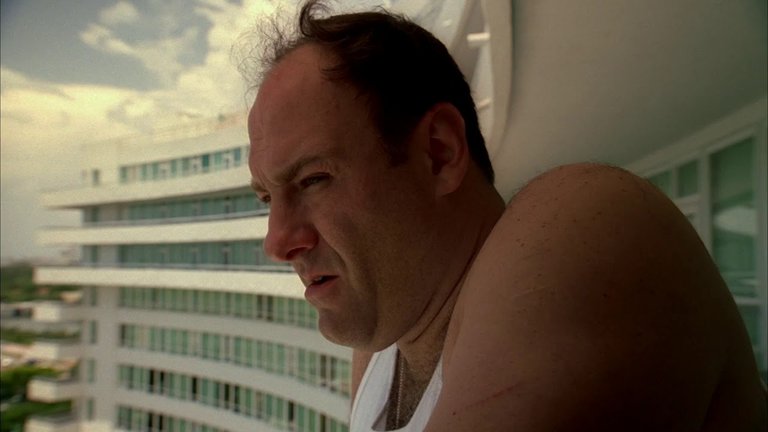
Calling All Cars (S04E11)
Airdate: November 24th 2002
Written by: David Chase, Robin Green, Mitchell Burgess & David Flebotte
Directed by: Tim Van Patten
Running Time: 47 minutes
The writers of The Sopranos have long excelled at defying narrative conventions, and Calling All Cars epitomises this skill through its titular sleight of hand. The episode’s name, evoking urgency via an antiquated police dispatch call, primes audiences for explosive drama. Yet, the hour unfolds as a subdued, almost meditative interlude—a deliberate subversion that underscores the series’ penchant for psychological tension over gratuitous action. While little occurs on the surface, the episode meticulously sows seeds for future turmoil: Tony’s fraying alliances, Janice’s Machiavellian manoeuvres, and the spectre of Livia Soprano haunting Tony’s subconscious. This dissonance between title and content reflects David Chase’s broader ethos: life’s most consequential battles are often fought in quiet moments of doubt, not gunfire.
The most pressing threat to Tony’s empire emerges from the Lupertazzi family’s greed, exacerbated by Ralph Cifaretto’s unexplained absence—a void that amplifies New York’s demands for a larger cut of the HUD scam. Tony’s reluctance to confront Carmine Sr. and Johnny Sack directly reveals his strategic pragmatism. Instead, he pivots to Florida, seeking an alliance with Carmine’s malapropism-prone son, Little Carmine (played by Ray Abruzzo), whose bumbling demeanour belies his potential as a pawn in Tony’s chess game. This détente, brokered through the rehabilitated Beansie Gaeta, underscores Tony’s preference for long-term stability over rash violence—a rarity in his impulsive world. Yet, the fragility of this alliance is palpable, foreshadowing the season’s explosive finale.
Bobby Baccalieri’s arc is a poignant exploration of mourning stagnating into self-destruction. His daily pilgrimages to Karen’s grave—burying cakes and confessing suicidal ideation—paint a man paralysed by loss. Enter Janice, whose manipulation of Bobby’s children—exploiting their fear of ghosts via a rigged Ouija board—transcends mere opportunism. By orchestrating a crisis, she positions herself as Bobby’s saviour, coercing him to symbolically relinquish Karen’s memory by sharing her final ziti. This act, equal parts tender and grotesque, encapsulates Janice’s duality: a manipulator cloaked in maternal concern. While Bobby’s tentative steps toward healing feel earned, the episode leaves viewers uneasy, questioning whether Janice’s intrusion is salvation or another form of entrapment.
Tony’s emotional unraveling is mirrored in his severed ties with two women. Svetlana, the pragmatic amputee, rejects him with a bluntness that bruises his ego—a rare instance where Tony is the discarded party. More consequential is his abrupt termination of therapy with Dr. Melfi, whom he blames for his stagnant self-awareness. Their final session crackles with unresolved tension: Tony’s kiss on her cheek—a blend of affection and defiance—signals his retreat into denial, while Melfi’s frantic call to Dr. Kupferberg reveals her unspoken dependency on their sessions. These ruptures highlight Tony’s cyclical self-sabotage, a man too entrenched in his flaws to embrace change.
With four credited writers—David Chase, Robin Green, Mitchell Burgess, and David Flebotte—the episode risks tonal disjointedness, yet emerges as a cohesive character study. At 47 minutes (one of the series’ shortest runtimes), it forgoes sprawling subplots for intimate vignettes, proving that brevity need not compromise depth. The script’s economy is its strength: every scene, from Bobby’s grave-side monologues to Tony’s curt negotiations, serves dual purposes of character development and thematic resonance.
Framed by Tony’s anxiety-ridden dreams, the episode leans into surrealism to offset its sparse plot. The opening sequence—a Fellini-esque car ride with Carmela at the wheel and Ralph’s caterpillar metamorphosis—teases Freudian symbolism (Carmela’s control, Ralph’s transformation) that Melfi futilely dissects. The closing nightmare, a Lynchian descent into a shadowy mansion haunted by Livia’s spectre, juxtaposes Tony’s waking denial with his subconscious dread. While arguably “artsy,” these sequences transcend mere ornamentation, crystallising Tony’s unresolved guilt and fear of inherited toxicity.
The episode’s Florida interlude offers a visual reprieve from New Jersey’s grim palette. The Fontainebleau Hotel, a mid-century modernist icon, serves as both setting and symbol—its sun-drenched glamour clashing with Tony’s inner turmoil. The final shot, of Tony gazing at the ocean after his Livia-haunted dream, underscores his perpetual exile from peace. By embedding The Sopranos within the Fontainebleau’s storied history (a backdrop for classics like Scarface), the episode subtly positions Tony’s saga within a broader cultural tapestry.
Calling All Cars is neither filler nor climax, but a masterclass in atmospheric storytelling—a reminder that in The Sopranos, the most profound emergencies are often those simmering beneath the surface, waiting to erupt.
RATING: 7/10 (+++)
Blog in Croatian https://draxblog.com
Blog in English https://draxreview.wordpress.com/
InLeo blog https://inleo.io/@drax.leo
InLeo: https://inleo.io/signup?referral=drax.leo
Hiveonboard: https://hiveonboard.com?ref=drax
Rising Star game: https://www.risingstargame.com?referrer=drax
1Inch: https://1inch.exchange/#/r/0x83823d8CCB74F828148258BB4457642124b1328e
BTC donations: 1EWxiMiP6iiG9rger3NuUSd6HByaxQWafG
ETH donations: 0xB305F144323b99e6f8b1d66f5D7DE78B498C32A7
BCH donations: qpvxw0jax79lhmvlgcldkzpqanf03r9cjv8y6gtmk9